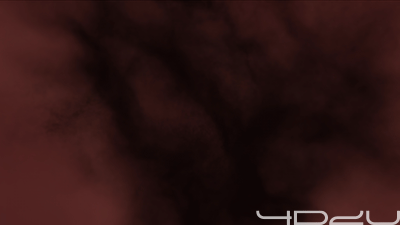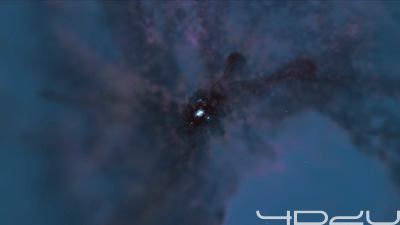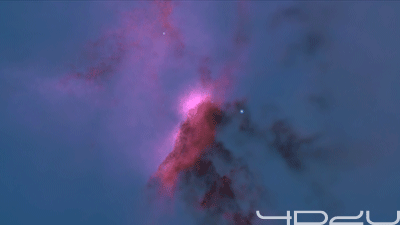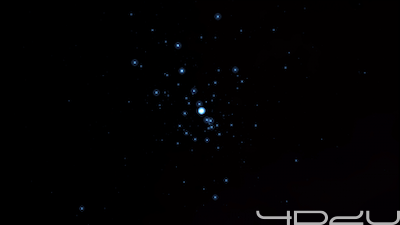Star Cluster Formation from Molecular Clouds (ver.2)
Stars are born in “molecular clouds,” which are low-temperature clouds of gas composed almost entirely of hydrogen molecules. It is believed that many stars are born at the same time and form star clusters. During the formation of a star cluster, massive stars ionize the surrounding molecular clouds, creating a bubble of hot gas called an ionized region. As the cluster formation progresses and the number of massive stars increases, all of the molecular clouds in the cluster are blown away by ionization, leaving only stars that are gravitationally bound together. This is known as a star cluster.
This video shows a simulation of the star cluster formation process by combining hydrodynamics calculations of a molecular cloud collapsing under gravity and calculations of the orbits of the stars born in the cloud as they move under the influence of the gravity from the molecular cloud and other stars.
 |
Denser areas in the molecular cloud gradually increases as they attract surrounding gas with their gravity. |
 |
Stars are born where molecular clouds gather and become dense. When a massive star is born, its light (the dimly glowing red area to the lower right of the center) warms the surrounding gas. At this time, the newborn stars are still buried in the molecular cloud. |
 |
As star formation progresses, multiple stars are born. Stars that are strongly scattered by gravity are ejected from the dense part of the molecular cloud to the thin outer part. The ejected massive stars ionize the thin molecular cloud, creating an ionized region (red) filled with hot gas. |
 |
Let's stop and take a closer look at the forming cluster. |
 |
The center of the cluster is still half buried in the molecular cloud, but at the center the molecular cloud is ionized and appears to have a hole in it. Star formation continues in the molecular cloud surrounding the hole. The Orion Nebula and the star clusters within it are thought to be in this stage. |
 |
Here we move forward in time again. In a star cluster that is just forming, gravitationally bound stars are moving around. When several stars approach each other, they are accelerated by each other's gravity, and some stars may fly out of the cluster. |
 |
As star formation progresses, there is more ionized hot gas (red) than cold molecular clouds (black). |
 |
Finally, all molecular clouds in the cluster have been ionized and lost, leaving only gravitationally bound stars. This is a diffuse cluster, such as the Pleiades cluster. |
Details of Numerical Simulation
| Purpose | To elucidate the formation process of open clusters and understand still forming open clusters such as the Orion Nebula. |
| Methods and Models | N-body/SPH simulations, star formation, radiative cooling, heating by radiation from massive stars |
| Number of Particles | 2 x 106 particles (gas), up to about 104 particles (stars) |
| Computer | Cray XC50 "ATERUI II" (CfCA, NAOJ) |
| Time Scale | About 10 Myr |
| Spatial Scale | About 10 pc |
| Resercher | Michiko Fujii (The University of Tokyo) |
| References | SIRIUS Project - IV. The formation history of the Orion Nebula Cluster driven by clump mergers SIRIUS Project - V. Formation of off-centre ionized bubbles associated with Orion Nebula Cluster |
Details of Visualization
This simulation solves for the motion of two types of particles, those representing stars and those representing gas. The ver.1 image was rendered as if the nebula was illuminated from the inside by bright stars. However, the images showed the distribution of the dark nebula even before it was illuminated by bright stars. In fact, dark nebulae appear in visible light as black silhouettes that block out the light behind them, unless they are illuminated by the light of a very bright star that has formed inside. To capture the feeling of such conditions, we have created ver.2 with a brightened background and the silhouette of the nebula shown in black. The color of the background itself has no meaning; it is colored to emphasize the gas clouds. When the gas finally dissipates, the background color changes back to black, so that the star clusters formed appear to float in space.
This ver.2 video is for flat images only; there is no version for domes or VR.
Credits
- Simulation: Michiko Fujii
- Visualization: Takaaki Takeda
- Four-Dimensional Digital Universe Project, NAOJ
Information
- 2025.6 Version 2.0 was released.

720p
StarCluster_v2_720p_mp4.zip (.mp4 (H.264), zip file : 210 MB)
StarCluster_v2_720p_wmv.zip (.wmv, zip file : 84 MB)
1080p
StarCluster_v2_1080p_mp4.zip (.mp4 (H.264), zip file : 421 MB)
StarCluster_v2_1080p_wmv.zip (.wmv, zip file : 155 MB)
Side-by-Side Stereovision, 1080p
StarCluster_v2_1080p_SBS_mp4.zip (.mp4 (H.264), zip file : 420 MB)
StarCluster_v2_1080p_SBS_wmv.zip (.wmv, zip file : 152 MB)